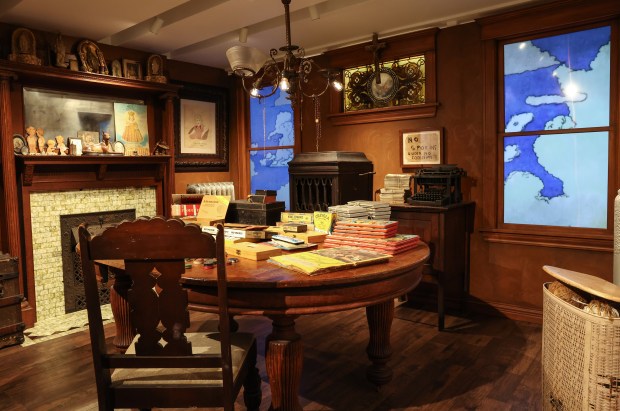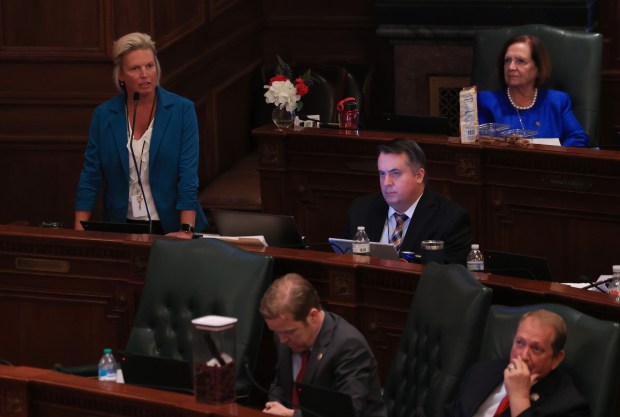Where most museums would open with a ribbon-cutting ceremony, the Intuit Art Museum, following a landmark $10 million renovation, reopened to the public recently with a ribbon-tying.
Public officials and other guests turned to their neighbors and connected the ends of their ribbon scraps to create a long, interconnected artwork that will remain in the museum’s collection.
It was an apt way to ring in a new chapter for this West Town institution. Since its founding in 1991, the museum has collected work by self-taught artists, often called “outsider art.” Before that, it was called “art brut” or “primitive art.”
But all those terms are — forgive the pun — on the outs. After receiving a transformative grant from the city’s Department of Planning and Development to refurbish its space, Intuit took its facelift as an opportunity to rebrand. What was formerly “Intuit: The Center for Intuitive and Outsider Art” now avoids the divisive “outsider” terminology to simply become “Intuit Art Museum.” It has a catchy acronym to boot: IAM, pronounced “I am.”
That streamlining extends to the gallery space itself. Intuit President and CEO Debra Kerr said the curatorial team has tried to use language that came directly from the artists or their families. When that wasn’t possible, the team tried to convey information as directly as it could, with no frills.
“We’re working really hard to eliminate some of that curator speak, if you will,” she said. “I don’t want this to be a traditional art museum.”
That comes across more pointedly at the new Intuit. Its Henry Darger exhibition and apartment recreation — one of its mainstays — has also been refurbished, now taking over a below-ground level of the museum. LED screens stand in for the walls and windows of the Lincoln Park apartment of the reclusive artist and writer. Down the hall, you can thumb through novels that inspired Darger’s epic about the seven Vivian Girls, sisters who fought to end child slavery.
“Of course, you can’t touch all the art on the walls or the sculptures on the pedestals,” Kerr said. “But we can make (the experience) more immersive and interactive.”
The installation “Henry Darger: The Room Revealed” is one of relatively few evergreens at the constantly-changing Intuit. Most of its gallery space — triple what it was before the renovation — will change out works periodically, whether they’re pieces on loan or from the museum’s collection. The ground floor is largely dedicated a rotating display of the museum’s permanent collection, with works by the likes of Mr. Imagination, Lee Godie and Wesley Willis. The Willis selection currently on display, from 1989, depicts the museum’s location at Ogden and Milwaukee avenues.
The second floor is completely devoted to special exhibits, beginning with the timely “Catalyst: Im/migration and Self-taught Art in Chicago.” The exhibition, which runs until early next year, features work by artists living and deceased who made their home in Chicago after living somewhere else. It makes bedfellows of far-flung and gripping works: the flamboyant and intricate oil portraits of Drossos Skyllas, a Greek immigrant; the collage art of Thomas Kong, a Korean-American convenience store owner in Rogers Park; and the freehand crochet of Pooja Pittie, a disability rights advocate who came to Chicago to pursue an MBA at the University of Chicago Booth School of Business.
Carlos Barberena, of McKinley Park, is among the artists featured in “Catalyst.” Originally from Nicaragua, his mexicano-inspired linocuts frame contemporary migration scenes with an almost Biblical grandeur. One of Barberena’s works, “Riding the Beast,” shows a young man stowing away on the network of freight trains running from southern Mexico to the U.S. — called “la bestia,” or the beast, by those who have survived the arduous journey. But not all survive. Its perils are represented by skeletons clattering behind the migrant, one cupping an hourglass just over his shoulder.
“Some of the works here have the same stories behind mine. One (artist) also took a train to leave their country because he was escaping genocide,” Barberena said. “We always think that we are not connected with each other, but everything is intertwined.”
Students will be able to take in such lessons through a learning studio at the back of the museum, already populated with youth artworks. Its grown-up equivalent, the Center for Learning and Engagement Opportunities — CLEO for short, named after founding board member and former Intuit president Cleo Wilson — will offer another space for discussion and decompression.
All spaces in the museum are ADA compliant, with a new entrance ramp and elevators. Visitors with disabilities and their accompanying care partner can enter the museum for free.
Kerr sees it all as part of her goal to make the new Intuit “the most welcoming and accessible space in Chicago.”
“If you come from a background where you never went to museums, I want this to be your first museum,” she said. “There’s no beaux-arts facade; there’s no grand staircase. Just walk into the storefront. Someone’s going to greet you, help you figure out what to do next, and off you go.”
“Catalyst: Im/migration and Self-taught Art in Chicago” runs through Jan. 11 at the Intuit Art Museum, 756 N. Milwaukee Ave., open 11 a.m. to 6 p.m. Wednesdays through Sundays, and until 8 p.m. every third Thursday; entry $15 adults; more at art.org.
Hannah Edgar is a freelance writer.




